Blobs in the right places – starting to paint
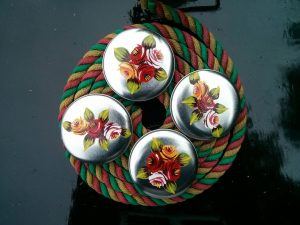
It’s almost a year since I first attempted to put the blobs in the right places and paint something that resembled the traditional painted roses found on the old working canal boats. It was a miserable time as I had just failed the written upgrade of my PhD and although I had passed the oral viva I was trying to make sense of what had happened and what to do next – a year on and I don’t think I am any clearer! Back then the blobs were very much just for decoration on Pea Green, and it was only in October 2017 when I finally made the decision to park the PhD indefinitely that I began painting and tentatively selling via Facebook. Forever the historian I have also continued to delve into the unclear history behind this very traditional canal boat adornment.
Art on Pea Green
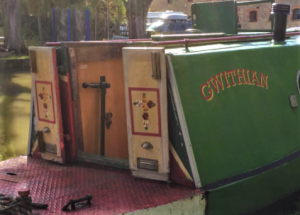
Pea Green already sported some roses when I bought her– clearly completed by two different people, one talented and one who wins a prize for having a go. I have to be honest the latter have now disappeared, hidden behind new panels on the front doors. As with most of this folk-art none of the pieces on my boat are signed, nor dated so I can’t say who did them or when. As my regular readers will know it was this on-board art that originally drew me to the boat, though at the time I really couldn’t distinguish between the different painters.
Roses and wheat
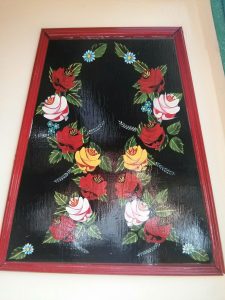
The best roses on Pea Green are on the front walls of the cabin in the cratch and on doors inside the bathroom ‘cupboard’ (the cupboard part reflects the size of the bathroom on my little boat). The artist had laid out the roses and forget-me-nots in a fluid design that I think is balanced and has a lively flow. I am always bothered when the flowers look too static or despite being on opposite sides of the boat all face the same way. The painting on Pea Green includes an unusual elements in the form of fine wheat or grass heads used instead of the usual green tendrils to fill spaces. The backdoors also had a similar design, but as the paint was peeling off I ultimately decided to repaint – plus I didn’t really care for the crucifix formation of the flowers.
Where does it come from?
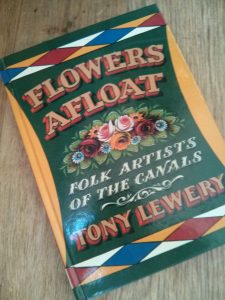
As someone obsessed with history, especially the social history of women and men, I have spent time delving into the back story of canal boat decoration here in the UK. Bearing in mind the wealth of material written about the industrial revolution I have been fairly staggered by the lack of writing on canal folk art. There is very little of depth written either from an academic or populist viewpoint. Despite my best attempts on Google Scholar, Ethos, JSTOR and other search tools I have failed to find much written about why roses and castles became the preferred art work of the working boats. The only fairly recent books with any depth of research are those written by Tony Lewery, who is also a talented artist. His book ‘Flowers Afloat, Folk Artists on the Canals’ was published in 1996 and apart from an article Lewery published in ‘Folklore’ a year earlier and another book he published in 1974 I can’t find any other substantive books or articles on the subject – which kind of adds to the mystery surrounding the art. (MMmmmm maybe I have hit upon a new line of research..)
Roma or merely roaming?
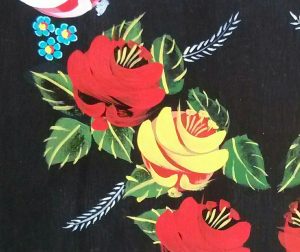
Of course folklore has begun to develop about the origins of flowers and castles on boats. The favourite is that that roses were in someway linked to the art found in Romany caravans, this ties in with other folklore that the original narrowboat workers were or Roma origins. However, there is little evidence of this, and if anything the canal art came before some of the Victorian Romany caravans. Popular culture continues to perpetrate this connection – just watch Peaky Blinders for the merging of the Roma with the waterways. Most historical evidence points to the early narrowboat carriers as being former farm hands or cart transporters. The so called ‘water gypsies’ were in fact an newly emerging group found on the edges of an industrialising society.
The art of the potteries
Anyway back to the painting. Lewery identifies a more likely inspiration for the canal art as the painted porcelain coming from the potteries and other romantic artists of the time. Basically, artistic fashions were transferred onto some boats. Added to this, flowers are often a favourite doodle for many of us, and perhaps it is as simple as some boat owners doodling on their boats.
Is there a right way?
What does come across from Lewery’s book is that there has never been a singular ‘correct’ representation of roses on narrowboats and the associated Buckby cans and horse-feeders. This seems to be a direct challenge to some today who will point a finger and suggest a wrong and a right way to paint the flowers. I feel those who do this fail to recognise that folk-art is constantly evolving and changing, and by its very nature is subjective. Styles developed in specific boatyards as new apprentices were trained by established artists and with each generation the art can be seen as developing and diverging whilst holding onto some key elements. What is also interesting is that some designs became specific to certain regions or canals like the ‘knobstick’ roses of the Anderton Company. These roses look far more realistic and less stylised than other designs, with the addition of tiny white blobs to the edge of the leaves.
Changing styles

Today, with global communication, Pintrest and Social Media many pick and choose elements to include in their canal art designs. As a form of folk-art I feel this is what should happen, though clearly for some this continuing evolution is seen as problematic. The photographs in Lewery’s books reflect the ever changing styles and approaches, and also identifies those who earned a living painting in the boatyards and the boat workers who as amateurs chose to decorate their own boats.
Learning the hard way
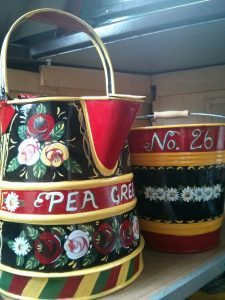
My efforts on Pea Green have definitely developed over the past year. I taught myself to paint after looking at examples of canal art online and watching a couple of YouTube videos. I also bought a book by Anne Young, which describes her personal approach to painting. As always, with money short I didn’t want to shell out on ‘proper’ i.e. expensive paints, especially if all I was going to do was paint a few bits on the boat. So, my ash bucket and Buckby can were painted with Dulux, which both actually standing the test of time, though my first roses look a bit dodgy. I think they are too round and overworked, and bear more resemblance to tortellini than roses! On the fire board behind the chimney I used acrylic paints and learnt very quickly that the paint was too thin and lacked flow. Acrylic paint just didn’t work and the end results looked more like a skeleton’s ribcage than rose petals. Of course I am now very bothered by both the fireboard, ash bucket and Buckby can and will be repainting when I have a nano second! The fireboard inparticular has to go as every time I look at it I am reminded of the Central American day of the dead!
Using Humbrol
As time has gone on I upgraded to Humbrol enamel aka ‘Airfix’ paints. Again, price was on my mind at £1.70 for a small tin it seemed worth the money as I began to paint more. Though again, I know that purists would argue this is the wrong paint to use. In the main I think Humbrol works well, it is a tough enamel and as long as you make sure the paint doesn’t become too thick it has a good flow and colour. For under £10 someone giving canal art a try could buy small tins of the primary colours plus black and white. This should be compared to signwriter enamel which is often around £7-8 for a 125ml tin. This soon adds up when you need to buy the primary colours and black and white paint.
And so it begins
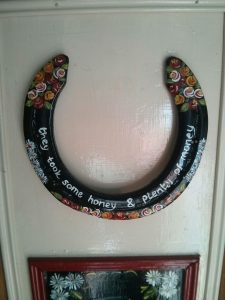
In September after painting the dodgy fireboard and Buckby can I decided to repaint a horsehoe. This old ‘shoe had been left on my boat by previous owners and had simple flowers and the name ‘Iona’. It was pretty battered and dull so I decided to add a line from Edward Lear’s ‘Owl and the Pussy Cat’ and decorate with tiny roses. I put a few pictures of it online in a couple of Facebook groups and before I knew it people began to ask how much the horseshoes would cost with boat names on. The tiny roses and boat names seemed to appeal to people and before I knew it I had a few orders.
Having a proper lesson
Since then I have painted all sorts and once I had my traders licence I began to sell from Pea Green. Finally May this year (2018) I decided I did need some professional artistic input and spent a day with Julie Tonkin, a Senior Journeywoman for the now defunct Waterways Craft Guild. (An organisation established in 1997 promote quality in traditional waterways crafts.) Julie passed on her style and taught me a number of elements I hadn’t thought of, as well as teaching me how to paint a castle design. This day was invaluable as I finally invested in some ‘proper’ and expensive brushes. Julie has also proved to be a great mentor since my day with her as she responds to my enquiries about the best way to do things.
Passing on the blobs
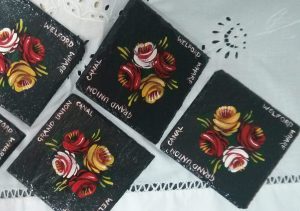
As I have continued to sell my painted bits and pieces I have also started to teach others the elements of painting traditional canal roses. In a couple of hours I have passed on the basics and groups have gone away with their own hand-painted coaster and greetings card. It has been great to work with people who are keen to learn about the history of the waterways and to discuss folk-art.
I continue to paint I in no way profess to being an ‘artist’ except, perhaps, where gin is concerned, but am working hard to ensure the blobs are in the right places.
keep up the good work ! cheers , Pat
Thanks Pat!
Interesting! I’m very sorry about the PhD biz, but the universe must’ve been trying to tell you something. You’ve been able to change your life with Pea Green, I think it is wonderful. I was also intrigued by canal art but never tried to research it, as I quite like the mystery of it. I brought a Buckby can home with me years ago, painted by a friend as I watched, prized possession! Best, Edith
How fab that you have a Buckby Can in Aus! Yes Pea Green has filled a hole, but there still seems to be lots of others to be plugged ;-(
Hi, have you any tips on lettering? I struggle with spacing and sharpness. I sell painted items by a river in Norfolk and worry that one day someone will ask me to paint roses on their boat and include some signage
Hello Andy, I am not a signwriter, so it’s hard for me to advise. I recommend Joby Carter’s signwriting book for tips. Hope this helps. Kay
Hi Kay,
So enjoyed your story.
Have always loved this kind of folk art and decided to pack away the crochet hooks and knitting needles for a while and take up the paint brushes!
Roses and castles are what I want to do but not sure about the castles ?.
You have given me the inspiration to give castles a go since I watched your tutorial.
Thank you so much.
Thank you so much for reading and commenting. Yes, castles do take time/practice. Am not sure what you watched, but it wasn’t me..! Thanks again.
Hi I wanted to try my hand painting some barge art what brush’s would you recommend for this thanks Gavin
Hello I use sable brushes for painting. They are horribly expensive!
Kay
Thanks I will look into it and see what I can afford might be a slow process but seeing you’re work has really made me want to have ago😊
Thanks I will look into it and see what I can afford might be a slow process but seeing you’re work has really made me want to have ago😊
Hi , I have read your story and it amazes me that starting as you say with blobs you have developed into those beautiful paintings. I have two painted milk churns that were painted in barge type flowers by a chap who showed his work at The Hampton Court Flower show. This must have been over 20 years ago and the flowers are fading badly. Do you know anyone who could repaint them for me please
Pauline
Apologies for the long delay in responding… Re your milk churn it depends on the condition they are in, I have stripped and repainted churns in the past. To be honest, faded flowers always look a bit grim if they have been ‘touched up’. Do drop me an email if you would like further info kayandrews2102@gmail.com
i heard this from an old man that was born on a barge, he said the castle is from the saying a mans home is his castle and the roses are because they have no garden on a barge.
Thank you for taking the time to comment. The much used phrase you mentioned, which actually referred to the right to defend your property, has become a much used trope but actually does little to provide accurate historical evidence as to why roses and castles were painted on boats and items used on boats across the canal system. A better historical conjecture can be seen in societal influences of the time, notably the development of transfer ware, ceramic painting, clock faces, japaning, artistic leanings towards the grand tour that trickled down into contemporary culture. Basically, painters copying the fashion of the day and translating it into fast folk art on boats. The quote you mention is, I think, an easy short cut to explain origins of something that isn’t well documented, unfortunately it has passed into modern folk lore, rather than being challenged with historical rigour.
What books would you recommend to learn canal art? I’m keen to learn before we buy our first boat.
Hello, to be honest there really aren’t any decent ‘how to books’ out there. I did a vid with David aka cruising the cut Feb 2023 where you can see the whole version of me painting. I also run one to one classes during the winter. The only other books are Tony Lewery flowers a float, this has lots of history and images, but isn’t without it’s problems. Also stem to stern is good, but all in black and white. Feel free to email/message me for more info.Kay